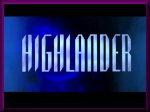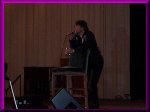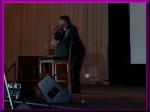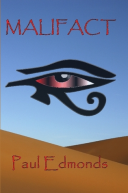



F Braun McAsh
 F Braun came on stage to demands for a photo-op, but replied that this was hard without a weapon to hand. He said that the original scripts for Highlander had been extremely specific about what was expected in the fights and it had taken him three years to break the writers of that habit. He felt they were wasting their time doing that, as they have no idea about the location or the weapons which would be used in episode. He said he had finally got them to "they fight", after which they left it to him. He said that the hardest part, for him, was the selection of the guest Immortal's weapon, as not only did he have to pick a weapon which matched the fighting style of the character, but he did not know in advance if the actor was left or right handed or how much room there would be on the set. He also had to consider what sort of weapon the character would use, for example, was it straight, curved or double-edged. He would also try to find out from the actor's agent as much information as he could, but he said that, generally, agents were clueless even about something as simple as whether their client was left or right handed, so he generally had to choreograph each fight twice, once left-handed and once right handed, so that he was ready to go when the actor showed up on the set.
F Braun came on stage to demands for a photo-op, but replied that this was hard without a weapon to hand. He said that the original scripts for Highlander had been extremely specific about what was expected in the fights and it had taken him three years to break the writers of that habit. He felt they were wasting their time doing that, as they have no idea about the location or the weapons which would be used in episode. He said he had finally got them to "they fight", after which they left it to him. He said that the hardest part, for him, was the selection of the guest Immortal's weapon, as not only did he have to pick a weapon which matched the fighting style of the character, but he did not know in advance if the actor was left or right handed or how much room there would be on the set. He also had to consider what sort of weapon the character would use, for example, was it straight, curved or double-edged. He would also try to find out from the actor's agent as much information as he could, but he said that, generally, agents were clueless even about something as simple as whether their client was left or right handed, so he generally had to choreograph each fight twice, once left-handed and once right handed, so that he was ready to go when the actor showed up on the set.
Asked what was the hardest weapons challenge he had had, he said that he had tried to use historical techniques as far as possible, but he had tried to give each fight a unique look. However, he would go with the designer of the weapon he had selected, as using it in a way in which it wasn't intended would force a hazard. His overriding consideration was that the weapon met the requirements of the story and looked good. Sometimes, it was difficult when there was a disparity in the length and weight of the two weapons, such as happened in The Revolutionary, where a Roman gladius was pitted against a katana. He quoted, as another example of this, the end fight from Rob Roy, a which had been choreographed by Bill Hobbs, one of F.'s teachers. Once you had found the length of the weapon, you had to choreograph for distance, otherwise the blade would change its target if you got in too close. For this reason, there is no room for error in a knife fight.
F has choreographed for ballet and opera as well as the sword, which requires a different approach. He said that you have to work within the musical framework, being aware of the length of the music and its dynamics, but you had to keep emotional contact with the music rather than becoming a slave to the rhythm. He had choreographed Romeo and Juliet several times and he said that the music actually tells you where the final hit his, but it's important not to let the fight to become synchronised to the music, otherwise it looks silly, with the actors moving at a constant speed.
He was asked if he had ever vetoed a location or asked for a change of scene, with particular reference to the polished floor in the episode "Methos". He said that that was the only occasion on which he came close, as the floor of the ballroom in which the flashback fight occurs had been polished by the janitor the night before they arrived. It meant a change in the fight, so that all the slides which you see Adrian doing were added in. The ballroom had 250 year-old chandeliers hanging from the ceiling which Braun had not been told about and they were hanging so low that they were within range of a sword, so he had to rearrange the fight so that they passed between the chandeliers. He said that, normally, you can get around waxed floors by pouring Coke on the floor to make them sticky, but this was not an option in this case and the only alternative, violin rosin, a was not available. As a result, the slides were added on the day and he said it was a good thing that David Robb was a very experienced swordsman.
 He said that he had encountered a problem with the pool constructed on location for the climax of Deliverance. He had been given a floor diagram and had choreographed the fight to go around the pillar, but when he arrived on site the day before filming was due, he found that the plans had omitted one vital piece of information - the fact that there was a three-and-a- half foot difference in floor levels on opposite sides of the pillar. As a result, the fight had to be "tweaked" and he said he will never tell where the designer's buried. He said he never got to go on a location scout, so as a result he was constantly telling the assistant directors to take measurements. He said he did occasionally veto a location, on the grounds that you can't swing a sword in a phone booth.
He said that he had encountered a problem with the pool constructed on location for the climax of Deliverance. He had been given a floor diagram and had choreographed the fight to go around the pillar, but when he arrived on site the day before filming was due, he found that the plans had omitted one vital piece of information - the fact that there was a three-and-a- half foot difference in floor levels on opposite sides of the pillar. As a result, the fight had to be "tweaked" and he said he will never tell where the designer's buried. He said he never got to go on a location scout, so as a result he was constantly telling the assistant directors to take measurements. He said he did occasionally veto a location, on the grounds that you can't swing a sword in a phone booth.
He was asked if he was ever faced with an actor who had never used a sword. He said this represented about 90 per cent of the actors who appeared on Highlander, as it was never a criteria in casting. He said that very few actors are trained in sword fighting, even in the UK. When he first started on Highlander, he used to teach the actors the basics, but over four years he learnt to just teach them the fight. He didn't do this willingly, as he said that half of the safety in a sword fight is knowing how to protect yourself if the other actor makes a mistake. He once added up how much time he had to teach an actor a fight and found that, over three to four days, he had four hours with the actor in which to teach him two or three fights. Thankfully, in episodic television, action sequences are filmed in phrases and sections and it is very rare to shoot a master shot of a fight. He said that actors rarely have the time or the skill to learn an entire fight competently enough to perform it. He said that the ones they had had on the show were David Robb, Anthony de Longis and Peter Wingfield, plus a couple of others. He added that, of course, he would include Adrian Paul with them as well. For a film, you would have weeks of rehearsal, but in making Highlander, he sometimes altered the choreography to fit the skill level of the actor. He commented that Wolfgang Bodison, who played Cord in Brothers In Arms, had never touched a bladed weapon before filming that episode and he said that he felt he was a natural, as he did so well.
He was asked if he'd ever had anybody hurt when he was teaching or choreographing. He replied that they had only had two minor injuries during his tenure on Highlander. The first was a French stuntman who had sustained a cut on his thumb which required one stitch during the Roman battle sequence in Take Back The Night. He had been somewhat concerned at this until he found out that the stuntman and his partner had run out of choreographed moves and had improvised - to make matters worse, they had been out of camera shot at the time! Braun had explained to them afterwards that they had run out of moves precisely because they were no longer within range of the camera. The other injury that was sustained was to Adrian Paul, who got cut over his right eye, (again, requiring only one stitch), during the filming of The Modern Prometheus. He put this down to the fight sequence at the end being filmed at the end of a 16-hour day that had seen Adrian doing everything, as he was directing the episode. Adrian and Jonathan Firth were moving between patches of light and dark, which required a three-second break in the choreography to allow their eyes to adjust to the different light levels and Adrian got hit on a move he had added, where he was grappling with Byron's cane and then spinning in a blind turn. They had rehearsed it 20 times, but in the third take of the fight, Adrian missed the cane and was so intent on grabbing it that he didn't block. Braun said that he had never been injured himself in a fight he had choreographed, although he did get hit in the face with a hammer in a play he was doing, which broke his nose. He said that Jonathan Firth had a habit of putting power into the last move of a sequence, which was not uncommon habit amongst actors and he had driven Braun's sword from his hand when they first rehearsed the fight.
He was asked about a comment on the website of one of the actors in Endgame that he was a "slave-driver". He didn't recognise the description, but admitted that he was insistent that people rehearse sufficiently. He said that he hadn't come across the comment because he doesn't have a computer. He took a bit about the problems shooting Highlander: Endgame in Romania and about getting to the set on time and with enough time. He said they were scheduled to shoot for 10 weeks and there were 13 complete rewrites of the shooting schedule in that time. Working from the original shooting schedule, he would rehearse the next fight due to be filmed, but the next one would not yet be choreographed. The changes meant that he had to film one fight with one day's rehearsal. In their 11th week in Romania, Bruce Payne fell ill and this threw filming into chaos, with the scenes to be filmed the next day being posted on a board in the production office the night before. He said he used to walk into the production office each evening, look at the board and say "there'd better not be a fight on there". He had six fights to choreograph for the film and the first took 15 days to shoot. He said that, with two weeks to go, the producers wanted to film the remaining fights in Romania and he said to them "do the math".
He said that Highlander had been one of the most challenging jobs in his life, as he had been no forced to be better each week in order to make the fights continue to be realistic. He said that Peter Wingfield had been trained in stage combat and this had helped for the final fight with Silas in Revelation 6:8. The original idea for Silas had been that he would use two axes, which combined elements of Viking and French design, but he said that this showed how designing weapons from scratch can be difficult, as you have no idea who is going to be cast often until the day before filming. In this case, as soon as he saw Richard Ridings, he realised he couldn't use the axes which appear in a flashback in the final fight, as Richard is so massive. Braun took a poleaxe slated for use in a later episode, cut two feet off the handle and modified the blade, but this left him up with a weapon which weighed four-and-a-half pounds and was hard to control. He said that they had used a helmet camera during the filming of the fight and that he had originally thought about using a hand-held camera. He said that, for this to work, you need an actor who acts with their whole body. He quoted William Shatner as an example, but said that Peter and Richard also do this. Asked about the expressions on their faces during the fight, he said that perhaps part of it was the strain of the fight and the long filming day, but he felt they were acting.
He said that the film contrasted with the television series in that the choreography on Endgame was choreography by committee, with input coming from all directions, not least from Adrian Paul, who had his own the martial-arts adviser with him. Nonetheless, Braun said that the end results look good.
He was asked how he coped with following on from Bob Anderson, who was sword master on seasons one and two of Highlander. He said that his first episode was The Samurai and that all of the fights had been katana versus katana, with the exception of the very first fight on the beach in the flashback. He had asked Dennis Berry if he had wanted the fights to be pure or weird and Dennis had opted for pure Japanese technique. As an aside, he said that Bob Anderson had been one of our Errol Flynn's stunt doubles and was an international competition fencer who had written the book on the rules of competition fencing. Braun said that they had different style and he felt that Bob Anderson lacked his insight into the historical background of the weapons. He had decided that he couldn't fill Bob Anderson shoes and that he had to be himself, but he was stuck with the choice of weapons that had been made for the recurring characters. He didn't like the swords that had been selected for Richie or Amanda. The only rapier which had been available for Richie was a poor choice and he had bugged Bill Panzer until it was replaced. He felt that Amanda's sword was too short. He said that the lack of time available in episodic television discourages film and stage choreographers from working in that medium and told us that that Bob Anderson was filming Lord Of The Rings in New Zealand.
He was asked if choreography can be over thought and replied that, if you look at one of his fights afterwards, he could tell you each move and who invented it, but when he's actually choreographing, he doesn't give a damn. What he tried to do was string together moved which made sense, whilst using the weapon properly and safely. He said what he was trying to achieve was to further the telling of the story and to develop aspects of the character which were only suggested in the dialogue. He felt that some choreographers did over intellectualise fights, but he felt that the character and the weapon had to dictate the fight and that it must be filmable above all, whether or not the fight contained his favourite moves. He said that you also had to consider the point of view of the camera and the range of the weapons you're using. He felt it was all right to analyse the results of a fight, but the you should never preconceive what is going to be involved.
Asked about his love of history and the martial-arts and which came first, he said that he had decided he wanted to act when he was 16 and had spent five years at drama school, four in Canada and one in the United Kingdom. Whilst he was at university, he had studied non-theatre courses. He had started to study sword and the martial-arts when he was 13 and during his time at university he was also working as a part-time ambulance attendant and in the military reserve, so he was living a very full life. There was only one person in his year who had more experience and, as a result, he was asked to choreograph the fights in their production of Romeo and Juliet. He said that he's done that Romeo and Juliet 13 times and that he's appeared in the play 12 times as an actor. He is often cast as Tybalt because of the fights. He became apprenticed to Paddy Creen at Stratford-upon-Avon and in his last year there they staged almost all of the historical Shakespeare plays in three theatres simultaneously. He said that his love of history had led him to the sword, but it was his love of theatre that led him to choreography.
